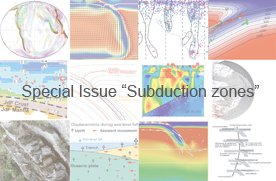Exhumation of (ultra-)high-pressure terranes: concepts and mechanisms
Abstract. The formation and exhumation of high and ultra-high-pressure, (U)HP, rocks of crustal origin appears to be ubiquitous during Phanerozoic plate subduction and continental collision events. Exhumation of (U)HP material has been shown in some orogens to have occurred only once, during a single short-lived event; in other cases exhumation appears to have occurred multiple discrete times or during a single, long-lived, protracted event. It is becoming increasingly clear that no single exhumation mechanism dominates in any particular tectonic environment, and the mechanism may change in time and space within the same subduction zone. Subduction zone style and internal force balance change in both time and space, responding to changes in width, steepness, composition of subducting material and velocity of subduction. In order for continental crust, which is relatively buoyant compared to the mantle even when metamorphosed to (U)HP assemblages, to be subducted to (U)HP conditions, it must remain attached to a stronger and denser substrate. Buoyancy and external tectonic forces drive exhumation, although the changing spatial and temporal dominance of different driving forces still remains unclear. Exhumation may involve whole-scale detachment of the terrane from the subducting slab followed by exhumation within a subduction channel (perhaps during continued subduction) or a reversal in motion of the entire plate (eduction) following the removal of a lower part of the subducting slab. Weakening mechanisms that may be responsible for the detachment of deeply subducted crust from its stronger, denser substrate include strain weakening, hydration, melting, grain size reduction and the development of foliation. These may act locally to form narrow high-strain shear zones separating stronger, less-strained crust or may act on the bulk of the subducted material, allowing whole-scale flow. Metamorphic reactions, metastability and the composition of the subducted crust all affect buoyancy and overall strength. Future research directions include identifying temporal and spatial changes in exhumation mechanisms within different tectonic environments, and determining the factors that influence those changes.






